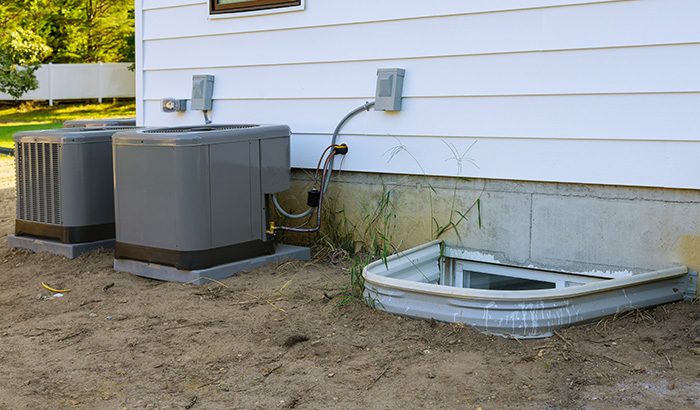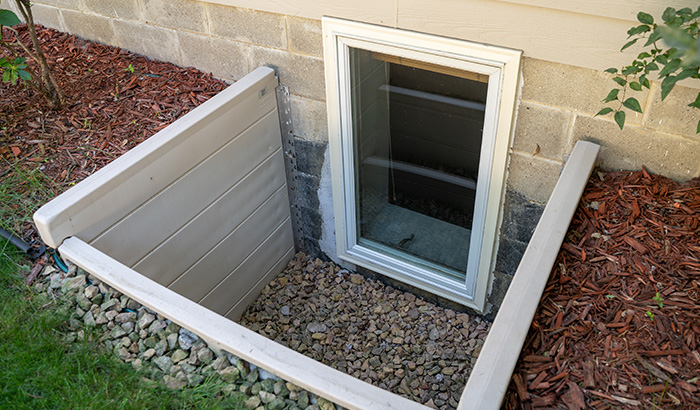Owning a home comes with a myriad of responsibilities and tasks that are required to keep your home in tiptop shape—including window well maintenance. It can be difficult to remember everything that needs to be done and how often. Checklists like this one can be helpful and even break down projects according to season.
However, since not all homes have window wells, this important task of tending to window wells is often overlooked. Neglected window wells can become ugly and distract from the beauty of your home. But more importantly, they can lead to hundreds of dollars in repairs if the window wells are not able to function as they should.
Why should I do regular window well maintenance?
If your home has a basement, window wells are essential to protect from different types of damage, ensure the safety of those living in the home, and provide natural light in an otherwise obscured part of the home. They are also important exits in the case of an emergency.
Now taking care of your window wells might seem pretty straightforward. Basically, you just need to make sure that your window wells are able to protect the windows of your home that are at or below ground level. Even though that may sound simple, there are some specific things to avoid during the process of window well maintenance.
Properly maintaining the window wells of your home can save you from costly repairs, so it is important to do it right. There are plenty of companies that specialize in window well care, but many choose to do it themselves. That is a great choice, but you might want to learn more about how to go about it yourself.
Here are six things not to do.
Only check them once a year
Many homeowners use “spring cleaning” as an opportunity to catch up on the things that might not be addressed throughout the year, like cleaning out the gutters or servicing your air conditioning unit. Of course, it is better to check on your window wells once a year than not at all, but it is recommended that you check your window wells every three months or so.
Inspecting your window wells over the course of the entire year can safeguard your home from damages that can occur from normal wear and tear, as well as seasonal damages from the different weather conditions.
Leave debris in and around your window well
You may think that as long as light can still get in the basement and water is draining away from the house, window wells can be left alone. Unfortunately, that is not the case. All debris should be removed each time you inspect your window wells.
Obviously, any large pieces of debris such as large rocks, branches and leaves, toys, or other debris that can be thrown out should be taken care of first. Then, consider using a shop vac to remove smaller debris that might be stuck to the sides or corners of the window well. This includes cobwebs and any muck that has accumulated since the last inspection.
Pack down the gravel
Most window wells should have about six inches of loose gravel at the bottom. The purpose of the gravel is to help dissipate the water that is collected in the well and allow for proper drainage away from the foundation of the house.
Over time, the gravel can become less effective as it settles or becomes mixed with dirt and gunk, making it more difficult for the water to dissipate and drain away. You can fix this problem pretty easily by adding new gravel or removing the existing gravel and giving it a good wash.
It’s important to remember when putting the gravel down into the bottom of the window well to not pack it down. The space between each piece of rock is what allows the water to dissipate, so try to leave the gravel as spread as possible.
Ignore roof drainage pathways
When inspecting the area around the window well, be sure to pay attention to other pathways that water might drain through. Just like the rain that washed the spider down the water spout, excess water from the roof has to go somewhere. Just make sure that somewhere is not in or around the window well.
The point of drainage systems is to allow water to move away from the foundation and toward a larger drainage system that connects to a municipal sewer. It’s important to make sure that all of the drainage systems are working properly and working together as they are intended.
Overlook loose window wells
You’ve inspected your window wells, removed any debris, given the gravel a little touch-up, and surveyed the other surrounding drains. It might feel like the job is complete, but you’re not quite there yet.
Another step is to ensure that the sides of the window well are securely attached to the foundation. If there is visible space between or the window well is easily shifted, it probably means water will be able to flow down in between and not make it to the drain in the bottom.
Performing window well maintenance may require re-caulking any loose areas so that the window well functions properly and protects your home from leaking water or flooding.
Install the wrong covers
A great tool for protecting your window wells is to install a cover. There are many options to choose from, so you are sure to find something that matches the style and needs of your home.
When installing a window well cover, the correct fit is crucial. If a cover is too big, too small, or the incorrect shape, it won’t be very useful in blocking debris from getting into the window well. Additionally, covers should be able to be lifted or opened quickly and effectively in the case of an emergency.
Get the perfect cover from Windowell Expressions
Since 1995, Windowell Expressions has been providing custom window well liners and covers with professional installation. Our experts can provide you with the perfect fit for your home and guarantee customer satisfaction. Make your window well maintenance easier and more effective with Windowell Expressions and request your free quote now!







